 A posse of Cowboys (and a Cowgirl!) strode into town Thursday morning, and moseyed on down to the Sebel Playford on North Terrace, just in time for Marathon Resources' Annual General Meeting, which was being held inside this mighty fancy saloon.
A posse of Cowboys (and a Cowgirl!) strode into town Thursday morning, and moseyed on down to the Sebel Playford on North Terrace, just in time for Marathon Resources' Annual General Meeting, which was being held inside this mighty fancy saloon.
You may recall that Premier Mike Rann had announced that his government would not tolerate 'cowboy operators' when he suspended Marathon's licence to drill in the heart of the Arkaroola Wilderness Sanctuary early last year.
These ornery dudes were itchin' to get back to drilling ("
it ain't thrillin' if we ain't drillin'!..."), and had brought their own cordless rigs along to demonstrate the 'real responsible' manner in which they'd like to go about it. They acknowledged there'd been mistakes in the past; "
we're sorry, and we won't do it again. But they went on to explain "
and hell, if we do do it again, well, we'll be sorry then, too!..."
In fact, it'd be hard to imagine a sorrier posse!
But leaving aside the opinions of this Wild Bunch, given the seriousness of Marathon's breaches of their exploration lease many of us were surprised when one of Sheriff Rann's Deputies - Mineral Resources Development Minister Paul Holloway - handed Marathon a renewed exploration licence for the same area last month.
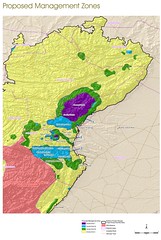
And many were also surprised when he went on to announce the publication of 'Seeking a Balance - conservation and resource use in the Northern Flinders Ranges.' Because from a simple glance - see at right - at the '
Proposed Management Zones' map on page 15 it's hard not to conclude that one of the main purposes of SaB is to allow for the creation of mining access corridors across the Arkaroola Wilderness Sanctuary.
For the only explanation I can conceive of for the strange 'exposed midriff' that runs along the centre of this map - a gap where only standard mining regulations would apply and the Department for Environment (DEH) would hold no sway - is that it is designed to let the mining industry extract uranium at Mount Gee in the centre of the Sanctuary and transport it to processing facilities on the adjacent plains.
corridors for wildlife - or whacking-great trucks?
You may ask yourself why, for instance, the northern side of the valley of the Mount Painter Creek is deemed worthy of DEH protection (the green peninsula that runs east from Mount Gee and Mount Painter) while the southern side is left to the industry? Why in a document that is supposedly based on sound ecological principles are there
no linking corridors form north to south in this spectacular wild region? Where are the values that inform the state government's NatureLinks program - that recognises the vital nature of biological corridors elsewhere in the state - in this instance?
The period for comment on this document closes on December the 19th.
It has been hard to clarify the meaning of so much of SaB - particularly the question of what constitutes 'infrastructure', and why this would even be being contemplated by the Department for the Environment in an area where under existing legislation - the Class A Environmental Zone for the Flinders Ranges (constituted under the Planning Act) - in order to preserve the character of the ranges any such 'infrastructure' is restricted to walkers huts and rainwater tanks!.
This issue will be dealt with specifically in my next post. And shortly a series of postings on websites - including this one - will go over all these issues in detail and call on lovers of the South Australian environment to have their say on SaB before the closure date.
For we can hardly afford to rest on out laurels...
shareholders on the march?
Because, inside the Marathon AGM, Chairman Peter Williams had an explicit message for Marathon's shareholders: after complaining that his company 'was not consulted' in the creation of the document (if it's any consolation neither was I, The Wilderness Society, or Marg Sprigg!) he asked shareholders to write in and express their views on Seeking a Balance:
The State Government has invited stakeholders to make submissions up to 19 December 2009 on its “Seeking a Balance”paper.
The Marathon Board encourages shareholders and other stakeholders to review the government document and, if thought appropriate, we ask you to make a submission to the Government outlining your own views on what the realistic “balance”should be.
Now, it's not hard to imagine what those views might be! But in case they didn't get it he went further, telling the Adelaide Advertiser;
Marathon chairman Peter Williams said the imposition of the "Seeking the Balance" management plan would set a dangerous precedent, as mining companies would no longer have certainty that the regulations they were working under were consistent and reliable...
"We find now that there could be areas of the state that have been previously subjected to conditions that are strict...and now we find that the government wants to impose some arrangements over the top.
they brought it on themselves
For a start, having been with Marathon since its inception Peter Williams knows only too well that the reason SaB even exists is his company's own track record in the Sanctuary!
Given that so many felt it was it was already outrageous enough that they were ever allowed in in the first place, even viewed purely tactically it is almost impossible to fathom how his company could ever have allowed such a dramatic breach of regulations to occur.
And if the mining industry are so keen on 'certainty' why don't they just accept that there are some places that they should not go, and the heart of the Arkaroola Sanctuary is one of them?

It's particularly hard to fathom why Paul Holloway's department sticks to its guns in such a bloody-minded manner on this issue. Perhaps it's their own Cowboy enthusiasms?
Because Seeking a Balance is, to put it bluntly, rather a dog's breakfast!
This is where we must consider the question of calisthenics. Even leaving aside for a moment the question of SaB's debatable environmental
bona fides, being prepared to go to such lengths to create a complex overlapping mosaic of regulations and ministerial responsibilities is pretty hard to reconcile with oft-repeated claims that the government want to streamline the mining industry's access across the state and provide 'certainty'.
Why not just face it; if you have to twist yourself into such a bizarre, convoluted shape in order to allow something then surely it's time to accept that there's an inherent problem with that very something?
no false 'balance'
Marathon presumes to claim on behalf of the mining industry that it's being hard done by in SaB, and the environmental movement certainly has little reason to be happy (leaving aside the long-overdue protections for the magnificent Mawson Plateau).
But any attempt by the government to play the 'we're being criticised by both sides, we must be right' game will hardly wash!
Because if SaB is really as, ahem, 'over the top' in regulating the environment of the northern Flinders as Marathon would have us believe, why did Mineral Resources Director Dr. Paul Heithersay tell the South Australian Chamber of Mines and Energy "it allows the majority of North Flinders Ranges to stay open to mining and exploration" but they "would be more nuanced about how we manage this"?
So much for any industry crocodile tears. There really is just one 'certainty' here: Marathon have demonstrated only too clearly why the mining industry and high-value conservation areas do not mix. Now let's just grow up and accept it.
As Greens MLC Mark Parnell told ABC news while the Wild Bunch capered behind him on Thursday -
"South Australia has a good future and a big future in mining. Over 90 per cent, in fact closer to 95 per cent, of the state is open to mining," he said.
"We need to make sure that our most important natural areas are protected and Arkaroola should be very close to the top of the list."
Sheriff Rann, it's time to run the cowboys out of town for good!
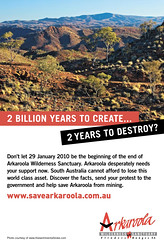 The public submission deadline for comment on 'Seeking a Balance - Conservation and resource use in the Northern Flinders Ranges' has been deferred until January 29th, 2009
The public submission deadline for comment on 'Seeking a Balance - Conservation and resource use in the Northern Flinders Ranges' has been deferred until January 29th, 2009

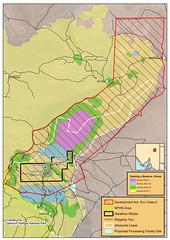
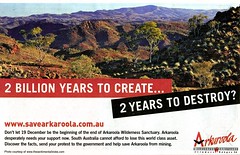
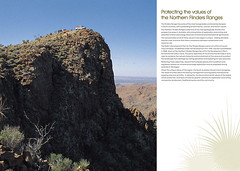
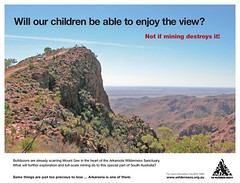
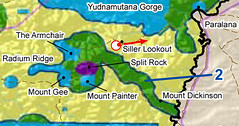

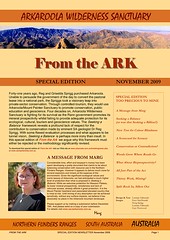




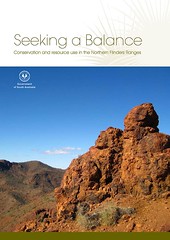
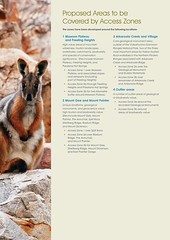
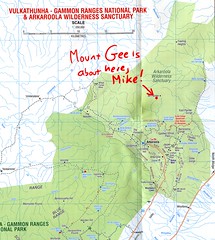

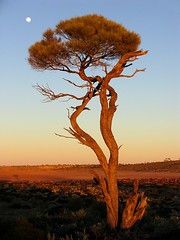

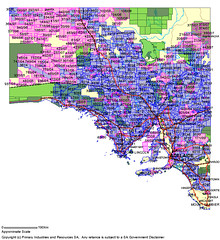
![link to the u[n]sa homepage](http://users.chariot.net.au/~greenh/blog/unknownsa_ublog-text.gif)


![link to the u[n]sa features page](http://users.chariot.net.au/~greenh/blog/features_ublog-text.gif)
![link to the u[n]sa kangaroo island feature image pages](http://farm2.static.flickr.com/1306/1187313059_93fdefd86b_o.jpg)
![link to the u[n]sa katarapko creek / murray river np feature image pages](http://farm2.static.flickr.com/1435/1181073355_b5c45f799d_o.jpg)


!['constellation' - wild country [national] set on flickr](http://farm1.static.flickr.com/155/415123844_3e6da621e5_s.jpg)

!['the bay serene' - the wild west [coast] set on flickr](http://farm1.static.flickr.com/121/312226516_606ac35455_s.jpg)








![u[n]sa journal -thanks for your time! u[n]sa journal - thanks for your time!](http://users.chariot.net.au/~greenh/blog/journal_ublog-text.gif)